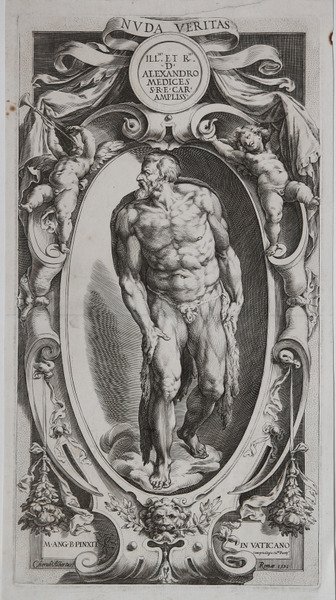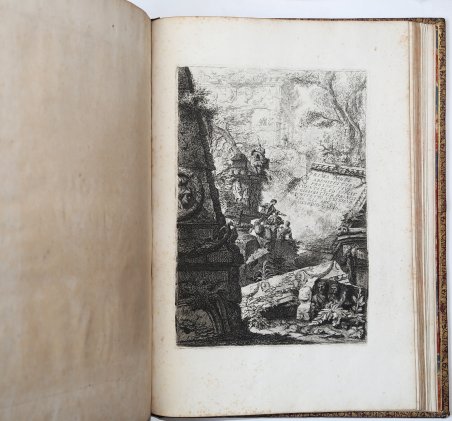PIRANESI, Giovanni Battista Opere Varie Di Architettura Prospettive Grotteschi Antichità Sul Gusto Degli Antichi Romani Inventate, ed Incise Da Gio. Batista Piranesi Architetto Veneziano. Raccolte da Giovanni Bouchrad Mercante Librajo al Corso. In Roma, MDCCL. Con licenza de’ superiori. unito a Jean Barbault, Les plus beaux monuments de Rome ancienne ou recueil des plus beaux morceaux de l'antiquité romaine qui existent encore: dessinés par monsieur Barbault peintre ancien pensionnaire du Roy a Rome, et gravés en 128 planches avec leur explication. Rome, chez Bouchard & Gravier. de l'Imprimerie de Komarek, 1761. 2° (52 cm), legatura in pieno marocchino rosso, triplice bordura dorata ai piatti, dorso a 7 nervi con decorazione floreali ripetute sull’unghiatura, titolo e tagli in oro zecchino, contropiatti in carta marmorizzata. Leggere fioriture all’interno. RARA COLLEZIONE delle più classiche vedute fantastiche del Piranesi, basata e comprendente alcune tavole della ' Prima parte di Architetture, vale a dire la sua prima e ricercata opera grafica, unita all’importante opera sulla Roma antica di Jean Barbault. Le due opere, racchiuse nello stesso volume finemente legato con legatura in marocchino rosso, sono entrambe stampate dalla tipografia romana di Bouchard & Gravier, una casa editrice e libreria con sede in Via del Corso a Roma, vicino alla chiesa di San Marcello. Iniziata da Jean Bouchard, poi affiancato da Jean Gravier - forse proveniente da una famiglia di librai di Briançon. Si specializzarono nella vendita di libri importati dalla Francia, ma pubblicarono anche loro stessi dei libri, molti con belle illustrazioni incise, tra i quali le Antichità Romane di Giovanni Battista Piranesi (1756) l’Hortus Romanus di Giorgio Bonelli (1772), con illustrazione di botanica incise da Maddalena Bouchard su disegni di Cesare Ubertini. Operando a Roma, senza la necessaria licenza dell’associazione dei librai ma con il sostegno della comunità francese, Bouchard & Gravier si specializzò nella vendita di libri e stampe francesi, e divenne un centro culturale della città, oltre che fornitore di libri per importanti biblioteche romane come il Collegio Romano e la Biblioteca Casanatense. Attraverso una rete di librai parenti di Bouchard la società era in grado di operare su scala paneuropea per offrire libri francesi al mercato romano: oltre 2.000 libri di questo tipo sono elencati nel loro catalogo nel 1780 (cfr. L. Mancini, La libreria Bouchard e Gravier di Roma. Profilo storico-documentario, in “La Bibliofilia” CXV (2) 2013, pp. 203-310.). Prima parte di Architetture fu la prima pubblicazione del giovane artista Piranesi, appena arrivato a Roma. Il risultato fu un’opera non del tutto unitaria, caratterizzata dalla notevole differenza stilistica tra le tavole, ma dal grande fascino e che lascia intuire e prevedere i futuri sviluppi artistici del Piranesi. Il lavoro continua una tradizione di un modello ormai affermato, che prevedeva il capriccio e la veduta, la scenografia ed il trattato di architettura, ma in seguito, analizzando la biografia dell’artista si comprenderà come soprattutto essere lo sbocco di una crisi come architetto e di un itinerario interiore vissuto con intensità. Insomma, il frutto dello scontro di una mente legata alla cultura veneziana erede della poesia delle rovine evocata da Marco Ricci e ripresa dal Bellotto e dal Canaletto, e la nuova cultura architettonica che si andava formando nel giovane Piranesi. Prima parte di Architetture e le successive fantasie architettoniche che la continuano costituiscono un passo decisivo verso lo scopo che egli si prefiggeva nella prefazione all’opera: far sì che il capriccio architettonico portasse a liberare l’architettura dalle catene del mondo materiale e sociale, per farne un’arte veramente liberale. ' La prima stesura dell’opera è databile al 1743, e venne dedicata a Nicola Giobbe, grande impresario. PIRANESI, Giovanni Battista Opere Varie Di Architettura Prospettive Grotteschi Antichità Sul Gusto Degli Antichi Romani Inventate, ed Incise Da Gio. Batista Piranesi Architetto Veneziano. Raccolte da Giovanni Bouchrad Mercante Librajo al Corso. In Roma, MDCCL. Con licenza de’ superiori. Joined with Jean Barbault, Les plus beaux monuments de Rome ancienne ou recueil des plus beaux morceaux de l'antiquité romaine qui existent encore: dessinés par monsieur Barbault peintre ancien pensionnaire du Roy a Rome, et gravés en 128 planches avec leur explication. Rome, chez Bouchard & Gravier. de l'Imprimerie de Komarek, 1761. 2nd (52 cm), full red morocco binding, triple gilt border to plates, 7-nerve spine with repeated floral decoration on the spine, title and cuts in pure gold, marbled paper backstrip. Slight blooming inside. RARE COLLECTION of the most classic fantastic views of Piranesi, based on and including some plates of the Prima parte di Architetture, that is his first and sought after graphic work, combined with the important work on ancient Rome by Jean Barbault. The two works, enclosed in the same finely bound volume with red morocco binding, are both printed by the Roman printing house of Bouchard & Gravier, a publishing house and bookshop based in Via del Corso in Rome, near the church of San Marcello. Started by Jean Bouchard, then joined by Jean Gravier - possibly from a family of booksellers in Briançon. They specialized in selling books imported from France, but also published books themselves, many with beautiful engraved illustrations, including Giovanni Battista Piranesi's Antichità Romane (1756) Giorgio Bonelli's Hortus Romanus (1772), with botanical illustrations engraved by Maddalena Bouchard from designs by Cesare Ubertini. Operating in Rome, without the necessary license from the booksellers' association but with the support of the French community, Bouchard & Gravier specialized in the sale of French books and prints, and became a cultural center of the city, as well as a supplier of books for important Roman libraries such as the Collegio Romano and the Biblioteca Casanatense. Through a network of booksellers related to Bouchard, the company was able to operate on a pan-European scale to offer French books to the Roman market: over 2,000 such books are listed in their catalog in 1780 (see L. Mancini, La libreria Bouchard e Gravier di Roma. Profilo storico-documentario, in "La Bibliofilia" CXV (2) 2013, pp. 203-310.). ' Prima parte di Architetture was the first publication of the young artist Piranesi, who had just arrived in Rome. The result was a not entirely unified work, characterized by the considerable stylistic difference between the plates, but one of great charm and one that hints and predicts Piranesi's future artistic developments. The work continues a tradition of a well-established model, which included the caprice and the view, the scenography and the treatise on architecture, but later, analyzing the artist's biography, it will be understood as being above all the result of a crisis as an architect and of an interior itinerary lived with intensity. In short, the fruit of the clash between a mind tied to Venetian culture, heir to the poetry of ruins evoked by Marco Ricci and taken up by Bellotto and Canaletto, and the new architectural culture that was forming in the young Piranesi. The Prima parte di Architetture and the subsequent architectural fantasies that continue it constitute a decisive step towards the goal he set himself in the preface to the work: to ensure that architectural caprice would lead to free architecture from the chains of the material and social world, to make it a truly liberal art. The first issue of the work dates back to 1743, and was dedicated to Nicola Giobbe, a great impresario at the service of the Camera Apostolica and protector of the young Venetian architect. Later, it was included in a wider discourse that also included the. Cfr.


Find out how to use
Find out how to use

